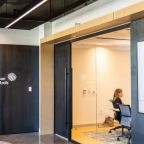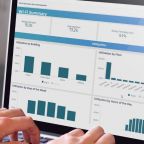What is digital twin technology? Before diving into the advantages of digital twin technology for building and facilities use, let’s first define what we mean by “digital twins:” more than a 3D model that shares a view of an object, digital twins are virtual representations of the physical environment, assets, systems, and/or processes based on multiple sources of data. The concept first came about in the early 2000s when it was used for manufacturing applications. Now, with hybrid work becoming the dominant work model, digital twin technology is gaining momentum among the business sector for its ability to provide visibility into a building or workplace’s overall performance.
According to our Chief Strategy Officer, Brian Haines, “…the concept of digital twins is where the real-world environment is modeled in data that is actionable, measurable, and reflective to live inputs. Think of digital twins as next-level building information modeling (BIM), only it can also account for people’s movement, air flow, how a building is constructed and other elements to develop a building lifecycle model where everything can be measured.”
What are 3 benefits of using digital twins to improve the workplace?
1. Helps organizations understand how to refocus and right size their real estate faster.
In the last few years, the role of the workplace has shifted from a place where work used to get done to a place for bringing together people for ideation, collaboration, and culture-building opportunities. This has presented both a challenge and opportunity for organizations looking for ways to optimize their ever-changing workplaces – both for the people who use them and for potential cost savings. With access to a visual representation that fully-integrates with quality workplace data and workplace management solutions – such as IoT sensors for occupancy tracking and indoor air quality (IAQ) measurement, tools for scheduling facility resources such as room, desks, vehicles and parkin, as well as the integration of building control and automation systems – business leaders can use digital twins as a powerful tool for quickly understanding workplace utilization, employee mobility, and much more. As a result, organizations are able to make informed decisions about their workplace needs that can better align with the way their people actually use the space and produce major cost-reduction opportunities.
2. Helps facilities teams respond to timely preventative and corrective maintenance needs.
This enables building teams to better predict future needs which can help reduce unplanned capital costs and keep facility resources operational. Because digital twins provide robust data of an entire building’s assets, equipment and building systems (e.g., HVAC, fire alarms, security systems, etc.), facilities teams can use digital twins to know exactly when and where maintenance issues are or will occur. This means facility managers are able to respond to timely maintenance issues more efficiently, while also being able to proactively manage preventative maintenance tasks. As a result, they’re saving on time and overall maintenance costs.
3. Helps organizations improve sustainability efforts.
Some workplace occupancy sensors, like ours at FM:Systems, can detect environmental conditions, like light, temperature, humidity, CO2 levels, and more. When this type of data is incorporated into a digital twin simulation, organizations can identify areas to reduce health and wellness risks for its occupants and improve energy consumption. For example, in a digital twin integrated with environmental data, organizations can visualize and identify areas for cutting down on unnecessary energy usage, like turning off the lights on a section of the building on the days and times of the week that have consistently experienced low occupancy. They can also use environmental data to uncover and resolve potential sources contributing to poor indoor air quality (IAQ).
“When digital twins are layered with high quality workplace environmental data, organizations can see how their current work arrangements are performing and test different designs to improve energy efficiency and provide work experiences that prioritize the health and well-being of their occupants. – Kurt von Koch, CEO, FM:Systems
Digital twins can also help organizations reduce unnecessary waste and emissions created during any construction project. Our CEO, Kurt von Koch, says, “When digital twins are layered with high quality workplace environmental data, organizations can see how their current work arrangements are performing and test different designs to improve energy efficiency and provide work experiences that prioritize the health and well-being of their occupants. And, because they’re able to do this all within a virtual environment, organizations can accurately pinpoint which layout, finish outs, and changes first, rather than embarking on a time-intensive, costly renovation project only to later learn it was the wrong design for their employees and sustainability goals.”











